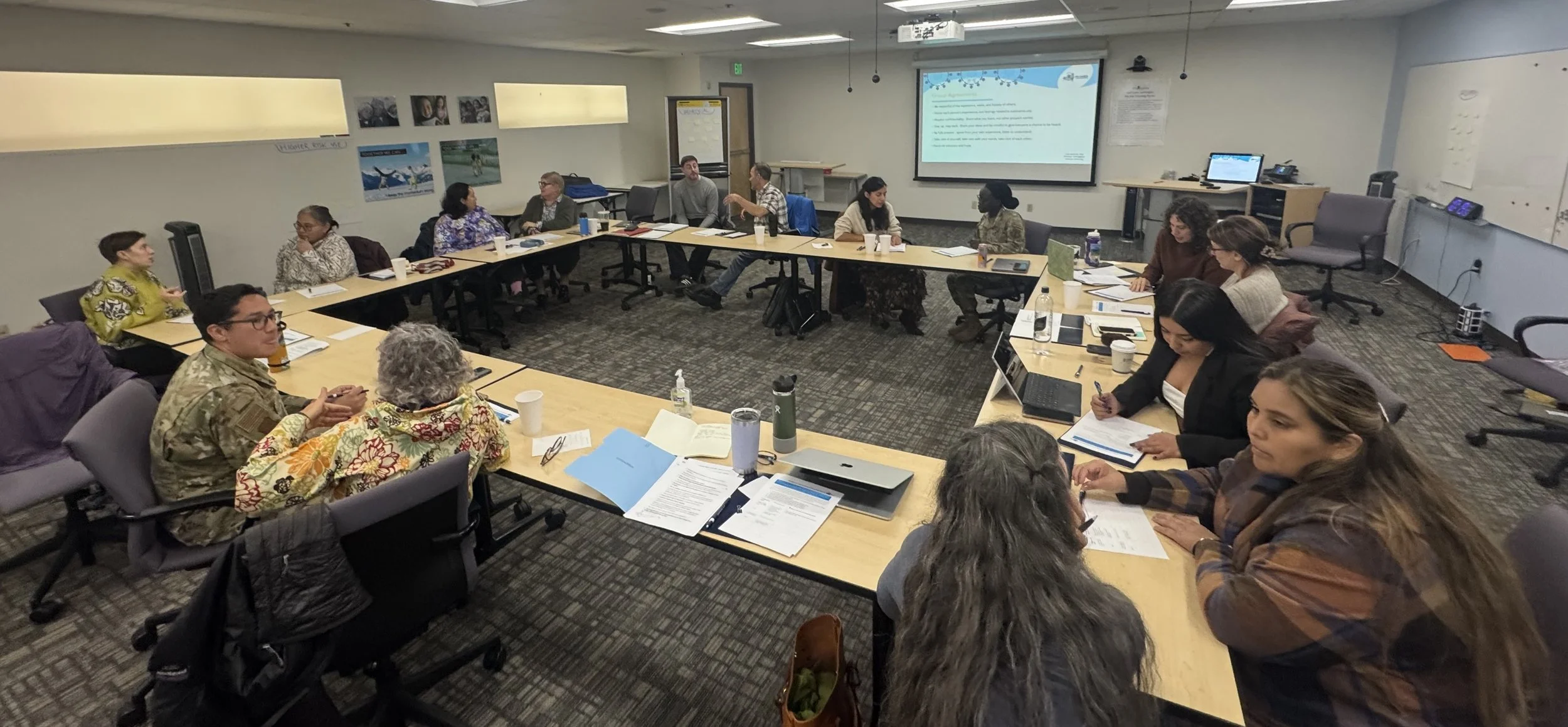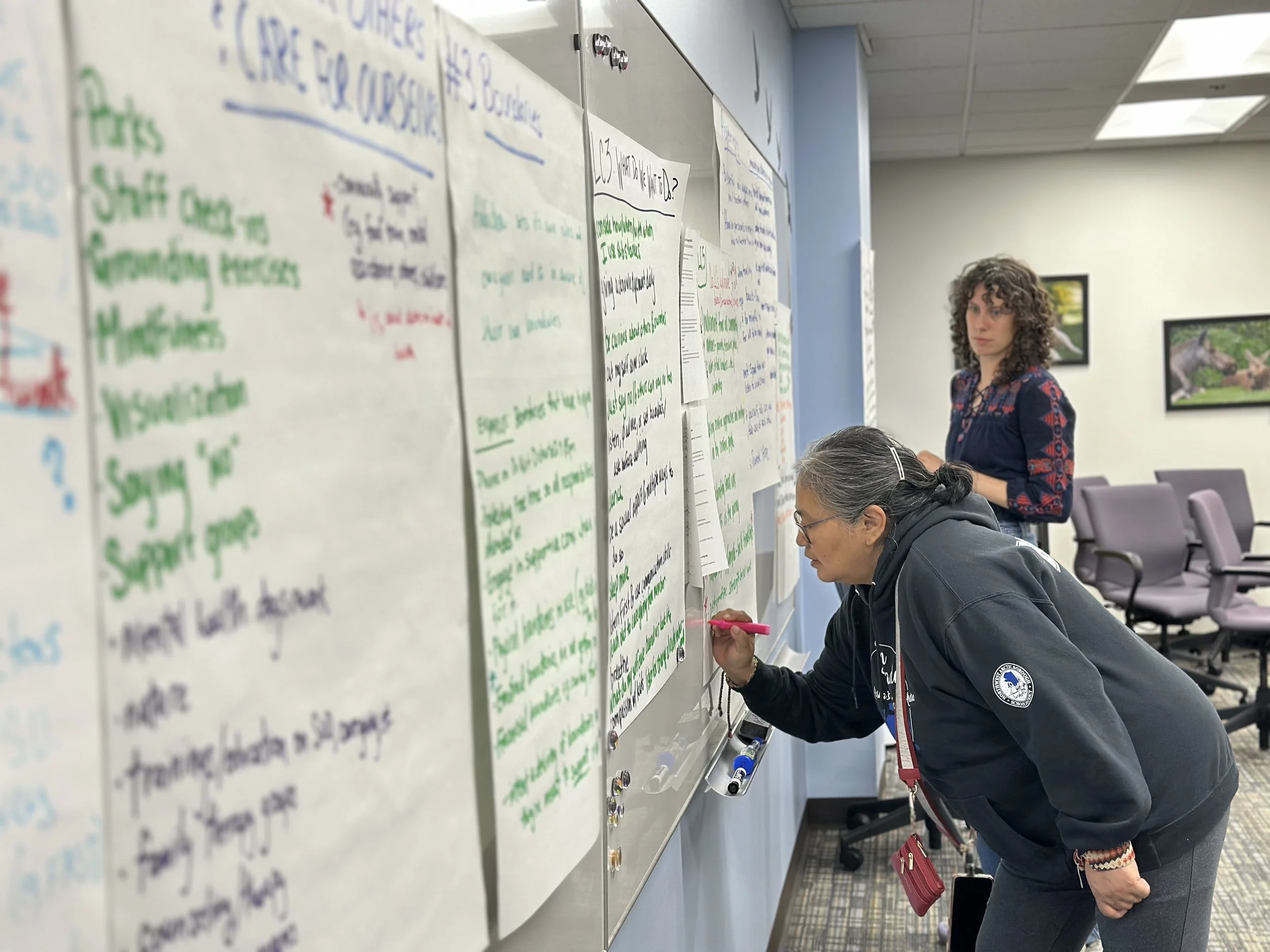Last month, our Community Advisory Board (CAB) and members of Yakama Nation Behavioral Health joined us for a three-day pilot of the PC CARES–ASU curriculum. The goal was simple: test the newest PC CARES curriculum — which focus on preventing at-risk substance use and overdose deaths — and gather feedback needed to refine the curriculum to make it actionable, culturally grounded, and community-centered.
Over three days, participants explored how de-stigmatizing language, youth prevention, support strategies, and harm reduction intersect in suicide prevention and community wellness. Here’s a quick recap of the sessions, what worked, and how CAB feedback will shape the curriculum.
Community Advisory Board members engage in a paired discussion activity in Anchorage.
Day 1: LC1 & LC2 – Words Matter and Youth Prevention
LC1: Words Matter and the Spectrum of Use
What worked: Clear structure, interactive group discussions, and a balance of guidance and flexibility
CAB Recommendations & Next Steps:
Use visual tools to guide participants through the learning circle structure
Refine the Spectrum of Use activity for clarity and flow
LC2: Youth-Focused Prevention and Early Intervention
What worked: “I statements” encouraged judgment-free dialogue, “Living Likert” activity encouraged engaging dialogue that helped members interrogate their own beliefs related to youth prevention on substance use.
“There is something about people trying, feeling, embodying… it makes the learning tangible.”
— Design Lab participant
CAB Recommendations & Next Steps:
Clarify and refine handouts and visuals
Further curate the information needed by community members to support youth substance use prevention. Remove anything that might create tangents (like strengths and drawbacks of YRBS methodology)
Add role-play or scenarios to make the learning tangible
Day 2: LC3 & LC4 – Support for Positive Change & Defending Health
LC3: Support for Positive Change
What worked: Motivational interviewing practice, skill-building exercises, and quotes helped connect participants to the material
“Love the motivational interviewing practice — this made it deeper, personal, real.”
- Design Lab participant
CAB Recommendations & Next Steps:
Clarify definitions (e.g., compassion) and specify roles (caregiver vs. person using substances)
Streamline session ending
LC4: Defending Health & Saving Lives
What worked: Community mapping, Narcan information/demonstration, and discussions on harm reduction and stigma
CAB Recommendations & Next Steps:
Integrate harm reduction with recovery pathways
Simplify handouts and exercises for clarity
Include messaging exercises for participants to share with their communities
Change community mapping exercise to include more voices (e.g., parents and others outside formal institutions)
Day 3: LC5 – Review & Next Steps
The final day focused on reflection and forward planning. CAB members shared what resonated most from the week, completed post-surveys, and offered feedback on the evaluation measures we’re testing. Together, we brainstormed practical ways to bring the refined curriculum to Alaska communities — discussing potential pilot sites, training supports, and ways to ensure local ownership.
The conversation was energized by a shared sense of possibility: that this work, rooted in both research and lived experience, can truly make a difference when guided by community voices.
Before PC CARES, I remember thinking and feeling about preventing risky substance use as a difficult task, and saw as being out of my scope of work/outside of my capacity as an individual. Some of what I have learned in PC CARES is that anyone can play a role in preventing or reducing substance use. Since learning in PC CARES, I now think/feel preventing risky substance use can be done by doing little things that can lead to positive outcomes or help to educate or even just simply help others struggling with substance use.
- Design Lab participant
Design Lab participant Roberta Moto priorities next steps during Learning Circle 5 as PC CARES staff member Tara Schmidt looks on.
Key Takeaways
The CAB’s feedback during this three-day pilot highlighted how essential it is to balance structure with flexibility, and to involve the voices and experiences of people effected by substance use—including caregivers, youth, and people currently using substances. Participants emphasized the need for clear visuals and tangible takeaways that community members can use right away — whether that’s knowing how to administer Narcan, or practicing compassionate conversations.
Looking Ahead
Next, we’ll refine the PC CARES–ASU materials using CAB recommendations and test the next iteration during the online series “Community-Driven Approaches to At-Risk Substance Use Prevention.” This iterative process of testing, gathering feedback, refining, and testing again are essential steps in preparing the curriculum for pilot implementation in Alaska and Washington communities. The next phase will include continued testing, new partnerships, and additional opportunities for feedback and learning. We’re also exploring ways to make these materials more accessible for virtual delivery.
We’re deeply grateful to our Community Advisory Board members and Yakama Nation for their time, wisdom, honesty, and care throughout this process. Their contributions continue to make this curriculum stronger, more relevant, and more responsive to the needs of communities.


